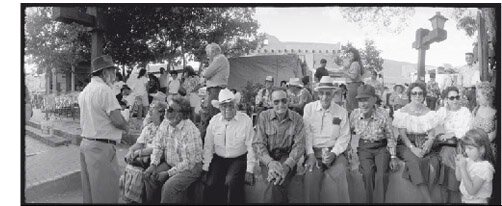|
MIGUEL GANDERT
__Professor Miguel Gandert, an award-winning documentary and fine-art photographer and filmmaker, is a native of Española, New Mexico and currently lives in Albuquerque, New Mexico. He received a Masters degree in photography from the University of New Mexico. Gandert is Distinguished Professor of Communication and Journalism and director of the Interdisciplinary Film and Digital Media program at the University of New Mexico where he teaches courses in photography, multi-media journalism, ethnography, media theory, and intercultural communications. His recent work explores the contrast between the Hispanic life in Spain, Latin America, Old and New Mexico. Gandert, who continues to work primarily in Black-and-white sees documentary work as both a form of art with a strong capacity for expression as well as a way of telling stories and understanding complex cultural relationships? A primary focus of those stories is Gandert’s mestizaje heritage and the fusion and tension of the relationship between Spanish Colonial and Native Cultures of the Americas.
__Miguel Gandert’s photographs have been shown in galleries and museums throughout the world and are in numerous public collections including the Museum of Fine Arts in Boston, the National Museum of American History and Art at the Smithsonian, and the Center for Creative Photography in Tucson, the Beinke Rare Book and Manuscript Collection at Yale, and the Museum of Fine Arts in Santa Fe. His series, Nuevo México Profundo, Rituals of an Indo-Hispano Homeland, was the subject of a book and one-person exhibition for the National Hispanic Culture Center of New Mexico, in 2000, and his work was selected for the 1993 Biennial exhibition at the Whitney Museum of American Art.
__Gandert is committed to inter-disciplinary work and his collaborated with numerous scholars. He has worked on numerous projects with Enrique Lamadrid including the award-winning book Hermanitos Comanchitos: Indo-Hispano Rituals of Captivity and Redemption, (UNM Press 2003)which won the Chicago Folklore Prize in 2004. His most recent book, The Plazas of New Mexico, with Chris Wilson is an architectural survey of New Mexico’s public spaces. He is currently working with Dr. Arturo Madrid on a Hispano Presbyterian memoir of New Mexico and with Enrique Lamadrid and Catherine Kurland on an Ethnographic project on Mariachi Plaza in Los Angeles, as well as a film with Charles Briggs and the Warao Indians of Venezuela on Indigenous health care inequities. __In the public art world, Gandert has had numerous public art installations, including grants from the state of New Mexico, City of Albuquerque, Bernalillo County and most recently a commissioned photographic mural Alma del Pueblo, for the Federal Courthouse in Las Cruces, NM. He is currently working on a photographic mural for the city of Santa Rosa.
 STEFANOS POLYZOIDES STEFANOS POLYZOIDES
__Stefanos Polyzoides received his Bachelor of Arts magna cum laude and Masters in Architecture from Princeton University. A registered architect in California, Arizona, Florida and New Mexico, he was born in Athens, Greece and has lived in Los Angeles since 1973.
__Mr. Polyzoides’ experience includes the design of educational, institutional, commercial and civic buildings, historic rehabilitation, housing, campus planning, and urban design. From 1973 until 1997, he was Associate Professor of Architecture at the University of Southern California and has been Visiting Professor at several prestigious schools of architecture. From 1983 through 1990, he was on the Advisory Board for the School of Architecture at Princeton University.
__He is a cofounder of the Congress for the New Urbanism, a national organization reforming suburban sprawl, and is a member of its Board of Directors. Mr. Polyzoides is a popular speaker on the subjects of new urbanism, transit-oriented development, mixed use development, housing, campus design and sustainability and is a frequent guest at academic symposia. With his partner, Elizabeth Moule, he founded Moule & Polyzoides, Architects and Urbanists in 1982. Across the nation and around the world, Mr. Polyzoides has led architectural and urbanist projects in New Jersey, Massachusetts, Florida, Texas, New Mexico, Arizona, Guatemala, Mexico, Anguilla, Dubai and Saudi Arabia, among other places.
__Mr. Polyzoides’ experience also includes leadership in the design and planning of educational institutions and the urban districts associated with their campuses. He has completed significant projects for Occidental College, New College of Florida, UCLA, the Claremont Colleges and the University of Arizona. These projects have addressed the full range of design issues which colleges and universities face today. The breadth of this work includes entire campuses, campus precincts, the variety of building types found within campuses and neighborhoods adjacent to campuses. This approach draws upon the full range of the firm’s capabilities, combing a deep knowledge of campus design with a significant general urbanist practice.
__Mr. Polyzoides’ recent projects include River North in San Antonio, Texas, an extension of the Riverwalk, and Master Plans for Downtown Santa Ana, Downtown Paso Robles and Downtown Whittier, California. He has also completed the East Downtown Albuquerque Master Plan, as well as numerous Downtown Specific Plans for mixed-use neighborhoods and districts in Southern California, including Downtown Ventura and Downtown Newhall.
__He is the coauthor of Los Angeles Courtyard Housing: A Typological Analysis, The Plazas of New Mexico, and is the author of R.M. Schindler, Architect. His research has produced four distinguished exhibitions and exhibition catalogs: Caltech: 1910–1950, Myron Hunt: 1868–1952, Wallace Neff, and Johnson, Kaufmann & Coate. Stefanos Polyzoides, with his partner, is a Seaside Prize recipient, the nation’s most prestigious award in the field of urbanism.
|
 CHRIS WILSON CHRIS WILSON
__J. B. Jackson Professor of Cultural Landscape Studies at the University of New Mexico (UNM) School of Architecture and Planning in Albuquerque, and founding director of its Historic Preservation and Regionalism Program, Chris Wilson, has written widely on architecture, tourism and the politics of culture in the Southwest. His current focus is on the role of the on-going reurbanization of the U.S. as a central sustainability strategy.
__Southwest. His co-authored book, La Tierra Amarilla: Its History, Architecture and Cultural Landscape (1991), won the Downing Award from the Society of Architectural Historians, and has been lauded as a model for cultural landscape studies. Noted historian Ramon Gutierrez has called Wilson’s The Myth of Santa Fe: Creating a Modern Regional Traditions (1997), "... a truly superb book. It deserves a wide and serious reading. Literary scholars will be inspired by its narrative strategies. Historians will marvel at its engagement with theory and its rich and varied uses of archival sources. And bibliophiles and lovers of things Santa Fean will delight in the book’s wonderful vignettes." If The Myth of Santa Fe deconstructs that quintessential American tourist town, his Facing Southwest: The Life and Houses of John Gaw Meem (2001) sings the virtues of one of its leading citizens and of the regional design tradition he helped to sustain.
__Cultural Landscape Studies. Everyday America: Cultural Landscape Studies After J. B. Jackson, co-edited with Paul Groth (2003), provides an assessment of Jackson’s contribution to the field, approaches to teaching landscape, the theoretical underpinnings of the field, and exemplary case studies of 20th Century landscapes.
__Reurbanization. As a Clements Fellow at Southern Methodist University (Fall 2006) and Paul Mellon Fellow at the Huntington Library (Spring 2007) Wilson initiated research on his next book, A Field Guide to Cool Neighborhoods, a study of pedestrian neighborhoods in the U. S. before and after the automobile.
__A native of Iowa, Wilson holds degrees from Yale and New Mexico. He was a free-lance writer and historic preservationists for fifteen years before becoming the Jackson Chair at UNM. His wife, Virginia Scharff, is a history professor at UNM, Women of the West Chair at the Autry National Center in Los Angeles, the author of eight history books, and of four novels, under the pseudonym, Virginia Swift.
|

